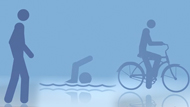Heart Failure Stages
Topic Overview
The American College of Cardiology and the American Heart Association have devised a classification system for heart failure. It categorizes heart failure based on how the disease progresses in most people. Under this system, heart failure is classified by stages A through D.footnote 1
|
Stage |
Definition |
Examples |
|---|---|---|
|
A |
Person is at high risk for developing heart failure. But there is no structural disorder of the heart. |
Person has high blood pressure, coronary artery disease, diabetes, a history of drug or alcohol abuse, a personal history of rheumatic fever, or a family history of cardiomyopathy. |
|
B |
Person has a structural disorder of the heart. But the person has never had symptoms of heart failure. |
Person has structural changes to the left ventricle, has heart valve disease, or has had a heart attack. |
|
C |
Person has past or current symptoms of heart failure. Symptoms are linked with underlying structural heart disease. |
Person has shortness of breath or fatigue caused by structural heart disease. Or the person does not have symptoms and is getting treatment for prior symptoms of heart failure. |
|
D |
Person has end-stage disease. He or she needs specialized treatment strategies. |
Person is often hospitalized for heart failure or cannot be safely discharged from the hospital. Or the person is in the hospital waiting for a heart transplant. Or the person is at home getting continuous intravenous support for symptom relief or being supported with a mechanical circulatory assistive device. Or the person is in a hospice setting for the management of heart failure. |
Related Information
References
Citations
Credits
ByHealthwise Staff
Primary Medical Reviewer Rakesh K. Pai, MD - Cardiology, Electrophysiology
E. Gregory Thompson, MD - Internal Medicine
Martin J. Gabica, MD - Family Medicine
Adam Husney, MD - Family Medicine
Specialist Medical Reviewer Stephen Fort, MD, MRCP, FRCPC - Interventional Cardiology
Current as ofDecember 6, 2017
- Top of Page
Next Section:
Related Information
Previous Section:
Topic Overview- Top of Page
Next Section:
References
Previous Section:
Related Information- Top of Page
Next Section:
Credits
Previous Section:
References- Top of Page
Current as of: December 6, 2017




